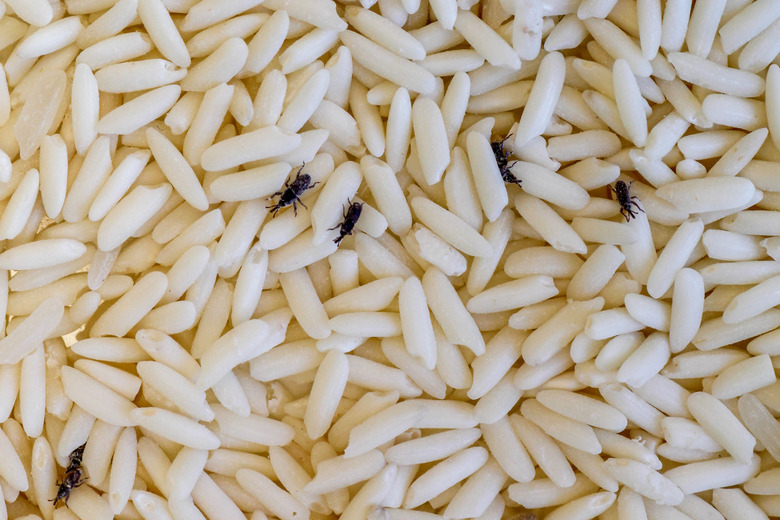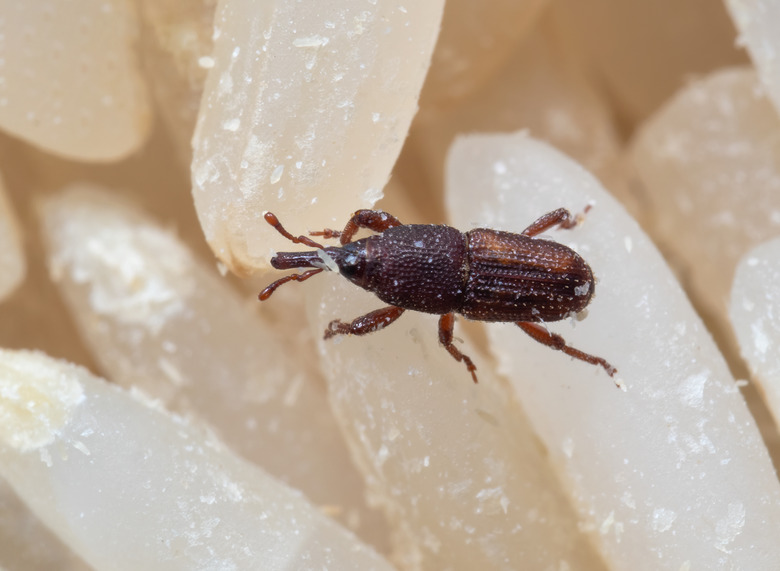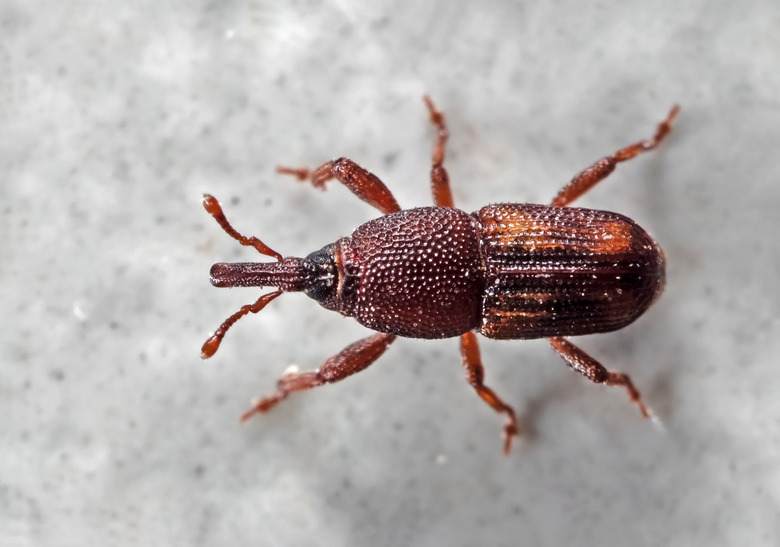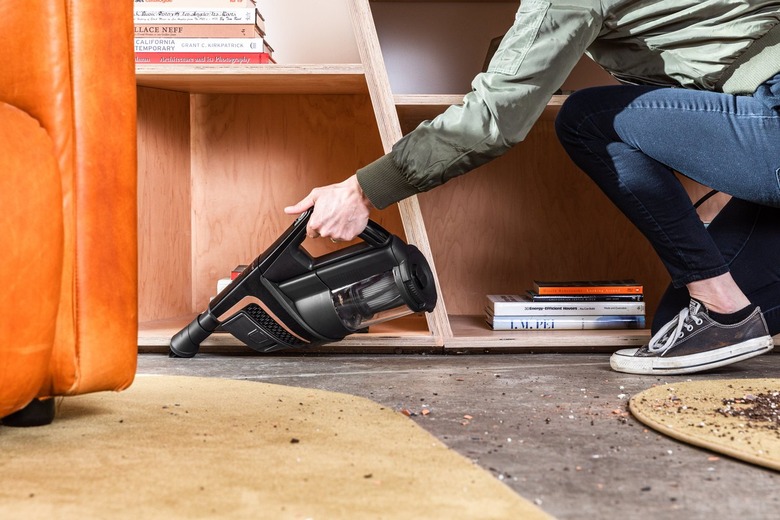How To Get Rid Of Weevils
We may receive a commission on purchases made from links.
You've grabbed a bag of rice or flour from the pantry, but something doesn't seem quite right — tiny, dark objects seem to be moving inside the package. These miniscule food munchers are most likely weevils (also known as rice weevils or flour bugs), a long-snouted form of beetle that most likely hatched from larvae inside the food packaging. While not harmful to humans, pets, or home structures, many types of weevils found indoors are known for damaging stored food products typically found in pantries and cupboards. Discard the affected food items and clean the area thoroughly to get rid of these pests.
What Do Weevils Look Like?
What Do Weevils Look Like?
- Species Name: Curculionoidae (family)
- Physical characteristics: Size varies from 1/8 to 1 inch, but they are typically on the small side and are brownish with a narrow snout. Some are wide and pear-shaped, while others are longer and narrower, but the slender, long snout is a common trait of many pantry-bound weevils. They all have a beetlelike appearance.
- Wings or wingless? Wings
- Color/species varieties: Brown to black and may have lighter markings mixed in.
- Life cycle and appearance: Weevil eggs and larvae are light-colored and are generally too small to detect. Adults are larger and darker and are easy to spot with the naked eye, even though they're often smaller than a grain of rice.
- How to tell apart from lookalikes: All types of weevils potentially found in pantry products are rather beetlelike in appearance. They are completely different from other pantry pests, such as Indian meal moths, which look like moths. Pantry moth larvae are large enough to spot as they wriggle in food matter, while weevil larvae are only 1/8 inch. The saw-toothed grain beetle, another common pantry pest, may at first be mistaken for a weevil or an ant. It has three antlike, separate body sections. Weevils are not ant-shaped no matter the weevil variety.
How to Get Rid of Weevils
How to Get Rid of Weevils
Getting rid of weevils indoors isn't difficult, but it may take a little time to determine whether they've infested multiple packaged food products. The most thorough job requires completely emptying the pantry or nearby cupboards to assess all the packaged starchy or grain-based foods as well as inspecting the pantry itself.
Discard Affected Foods
As soon as you find any infested food, such as a bag of flour, place it in a plastic bag, tie or otherwise seal the bag, and discard the bag in an outdoor trash can. Don't discard the item in the kitchen trash, as some weevils may find their way out and back into the kitchen. The goal is to get the weevils out of your house and keep them out.
Check Other Nearby Packages
If the weevil-infested package has been in your kitchen for a while before you discovered the problem, there's a chance they've worked their way into other packages too. Any easily penetrable packaging, such as cardboard pasta boxes or paper flour sacks, may have weevils inside. Even a box containing cereal may have weevils in the actual box outside of the inner packaging.
Open food boxes and previously opened packages and thoroughly inspect the contents. If you're relatively certain there are no weevils within, place those foods in airtight storage containers. If the packaging has already been opened and you don't spot any weevils but still don't feel comfortable about the potential, discard that food item too simply for peace of mind. Also discard any type of food package, such as cellophane-style pasta bags, if you find a hole in any of them.
Freeze Salvageable Foods
If you've stored dry goods, such as bags of flour, in the general weevil infestation area, place these products in the freezer for at least four days even if you don't believe they are in the package. The freezing temperature kills any hidden weevils, eggs, and larvae as well as any other types of pantry pests. Afterward, for these products and any new grain-based goods you buy, consider storing them in the fridge or freezer in airtight containers. This prolongs their shelf life and prevents any types of pantry pests from finding their way into the foods.
Thoroughly Vacuum the Area
Unless you've noticed weevils in other areas of the kitchen or even in another room, there's a good chance the affected area is limited to where you found the weevils, such as the cupboard where you keep cereal. Remove all items from the shelves and look around with a flashlight, checking for more weevils in the cracks and crevices. Vacuum up any you find and give all the shelves a thorough vacuuming to remove potential larvae, eggs, or spilled foods. Empty the vacuum canister or bag into a trash bag outside rather than indoors to prevent reinfestation. With a removable-canister vacuum cleaner, thoroughly wash out the canister before bringing the vacuum cleaner back into the house.
For weevils found in your home but outside of food storage areas, either vacuum them up or sweep them up with a broom and dustpan and discard them outdoors. Some types of weevils live on plants outdoors and may have found their way inside through cracks or gaps. These also are not harmful to anything other than the plants they prefer to consume.
Wipe Down the Shelves
Once the pantry shelves are empty, wipe them down with a damp cloth or sponge. Do not use harsh cleaning sprays, as these should not be used on areas where stored foods might absorb the residue. A cloth with some soapy water is enough to pick up any remaining fine food particles, such as loose flour missed by the vacuum cleaner or even a stray weevil egg. This process also helps remove any food sources that may attract weevils or other pantry pests. Allow the shelves to dry thoroughly before replacing items stored on them.
Avoid Using Insecticides
Removing weevils physically rather than with pesticides is the best option indoors. Pest control products like insecticides should never be sprayed in or on areas that may come into contact with foods and food packaging. Many insecticides contain chemicals that are toxic or otherwise dangerous to people and pets.
Consumer products labeled as pantry pest traps use pheromones to attract specific insects. Most of these attract moths rather than weevils, so they are of no use if the problematic pest is a weevil. Commercial-grade weevil pheromone traps are available, but these are sold in bulk packages for food growers and storage facilities. A home infestation should be easy enough to control with a vacuum cleaner, by removing infested items, and by repackaging similar foods in airtight containers.
How Weevils Get in Your House
How Weevils Get in Your House
Though they could get indoors by flying or crawling, weevils typically arrive in a home by hitching a ride inside packaged pantry items, such as rice, flour, cereals, and sometimes dried beans or peas. Adult weevils lay eggs in those food products long before the packages show up on store shelves or in your home. The eggs and larvae are practically undetectable due to their small size and light color, but once weevils reach the adult stage, they're easy to spot in light-colored foods since the weevils are a contrasting dark color. They generally won't breed indoors if the affected package is discarded as soon as the problem is noticed, and the pantry is thoroughly cleaned.
How to Prevent Weevils
How to Prevent Weevils
Though there's no way to know for certain if weevil eggs or larvae are in any product bound for the kitchen cupboards, a few practices help minimize their occurrence in the first place.
- Only buy the amount of pantry products you'll consume soon. It may be tempting to buy multiple bags of flour or special pancake mixes, but it's best to only buy what you'll use in a reasonable amount of time. For instance, if several bags of flour sit in your pantry for two years, there's a much greater chance of weevils or other pantry pests inside the easily penetrable packaging.
- Use air-tight containers. Placing any dried type of pantry staple in either the refrigerator, freezer, or airtight containers also helps prevent infestations. Quality kitchen storage containers, such as clear canisters with airtight lids, are a great choice for beans, rice, oatmeal, and the like, as it's easy to see what's inside. They also look sleek in a pantry or a kitchen counter.
- Use labeled, zippered bags. If you keep any such goods in their original cellophane or plastic packages, once you've opened them, store the contents in zippered storage bags. Write the date on each bag to indicate when you opened the product or at least the "use by" date found on the original packaging.
- Clean the pantry. Wherever you store food, clean it out at least once or twice a year, discarding past-date food products and items you've opened eons ago and only used once or twice.Wipe down all the shelves as well.
- Wash containers. Before you refill any storage containers used for pantry staples, wash them first to remove old food residue.
- Use chip clips to seal. Any time you open a box of cereal, roll the top of the bag closed and seal it with a chip clip or large rubber bands, which helps prevent pantry pests and keeps the cereal fresh even during humid weather.
- Inspect any open packages. If it's been open for more than a few weeks, inspect open product packages before using them again.
Do Weevils Cause Damage or Spread Disease?
Do Weevils Cause Damage or Spread Disease?
The types of weevils found in packaged food products don't spread disease or damage structural components. The only real loss is the money spent on the affected food products. In other words, there's no major cause for concern when finding weevils in the house, as these insects are pests more than anything else, and they don't even bite. Sizable infestations of weevils on farms or in large gardens may damage and destroy some plants, however. Any affected plant-based foods grown should be discarded.




